Contes Blasco Ibañez – Ruta 2
Dades bàsiques
Between 1 hour and a half and 2 hours
St. Joseph's Bridge
The Llotja
The second itinerary of Blasco Ibañez’s stories can take us from the bridge of Sant Josep to the places where the chapel of the blanquers’ guild was located, opposite the Alameditas de Serranos. Next, you will access the Palau de la Generalitat, where centuries ago the Royal Audiencia was, and bordering the Miguelete you will cross the old area of Les Argenteries to end at the Plaça del Mercat and finish the route next to the Llotja.
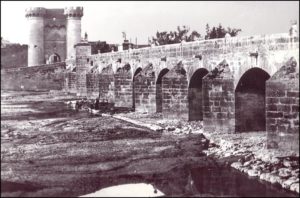
And as proof that he was not afraid, as he passed the San Jose Bridge and everyone in the city, he threatened with a pair of gloves to try to accompany him.
In this second itinerary, we will reach the historic center of the city, starting from the west and crossing the bed of the Turia through the same bridge through which ran the roder that starred in the truculento story, already mentioned, of «Valencian Guapeza». The San Jose Bridge has known various names over time. Built throughout the fourteenth century with a wooden structure, it was known as the Burner Palanca due to its proximity to an old crematorium. The flood of 1517 severely damaged him, so it was necessary to find a solution to the occupation of stalls. Between 1604 and 1607, Jerónimo Negret and Sebastián Gurrea directed the construction of the stone bridge, which would also become known as Puente Nuevo, de la Santa Cruz or de la Zaidía, although the name that has survived is San José, name taken from its proximity to the convent of San José and Santa Teresa. and the San Jose Gate destroyed when the city walls in 1868.
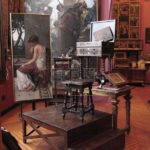
In the Benlliure House Museum, owned by the municipality, it is possible to visit the different rooms of the painter’s residence, but also his studio and garden, as well as admire his works or those of his brothers and his son Peppino Benlliure.
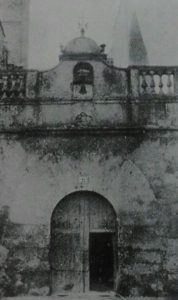
As soon as the board of the respectable guild of whitewashers meets in its chapel, immediately in the towers of Serranos
In Blanqueries street, a few meters after passing the building where the Benlliure House Museum is located, is where the chapel mentioned by Blasco Ibáñez in the story “The Last Lion” was built. More specifically, it occupied number 22 of what was once Emmuralle de Serrans street. This space that no longer exists serves to evoke two motifs: one, that of the old whitewasher’s trade, consisting of tanning and dyeing leathers. Its location near the Rovella irrigation canal is due to the fact that this work required the use of water and, in addition, the use of substances with a very strong smell made it advisable to locate the activity on the outskirts of the city. For this reason, pipes and circular ponds have been found that run close to the wall.
Secondly, the whitewashers’ guild and its distinctive symbols possess a legendary flavor, as the cited tale demonstrates. As it is explained, after the theft of the custody of Torreblanca by the Moors of Tredeliz, in the last decade of the s. The whitewashers played a decisive role in rescuing the Holy Eucharist at the hands of the Barbary pirates. The help obtained by a miraculous lion justifies the appearance of this creature both in the guild flag and in the anonymous oil Altarpiece of the Blanquerers’ Guild (1600).
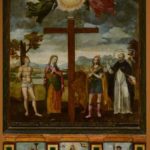
The Altarpiece of the Blanquers’ Guild is currently exhibited in the City Museum, an attractive gallery where, in addition to paintings by Valencian artists, it is possible to admire sculptures, engravings and other relevant pieces in the history of Valencia.

In the middle of winter he left his hut almost at dawn on his way to the Seminary.
Hanging out of his wife, in fat plunder, what he had to devour between class and class in the amedas of Serranos; half a brown bread with something else that, unnourished, deceived his hunger; And crossed on the skin, in Guisa de Bandolera, the enormous iron pañuelo enveloping the Latin and theological texts that danced behind its back as movable Joroba.
Just in front of the headquarters of the whitewashers, there are the Serranos malls that are spoken of in the story “Nche de bodas”, about the route that Visantet made from the orchard to the Seminary. This future priest, who in the story feels an atrocious life dissatisfaction when seeing Toneta, his childhood friend, married, ate in the gardens designed by Cristóbal Sales and Francisco Ferrer, and which are located between the bridges of San José and La Trinidad, extending on the right bank of the Turia, between the old Christian walls and the river wall. Known as alameditas de Serrans due to their small size, since 1832, in these elongated and narrow gardens it is possible to admire various sculptures dedicated, among others, to figures of the stature of Federico Mistral, José Benlliure or Azorín.
Like the character in the aforementioned story, Blasco Ibáñez would once again evoke this space in the novel “Arroz y tartana”, at a time when the perception of the environment acquires dreamlike overtones.
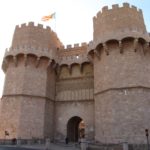
The towers of Serrans, one of the gates of the Christian wall, were built between 1392 and 1398 by master Pere Balaguer. This menada construction is part of the municipal network of museums and monuments.

The cars and Pillín absorbed him, and by the mornings he had to make a painful effort to deliver the child to mama and march to the High Court… What ministers of justice! They certainly weren’t parents. Because we are going to see: what would the magistracy lose with which he took Pillín to the Chamber, sitting him next to him to witness the triumphs of the Pope?
Continuing our itinerary, we will pass under the imposing Torres de Serrans to walk along Serranos Street until we find the Plaza de Manises. We are heading to the building that once housed the Audience. There he worked, in the moving story “La caperuza”, the prosecutor Andrés García, a character whose routine would be shaken after the fate that awaited his beloved son Pillín. As Minister of Justice he moved to the Royal Territorial Court, located for more than a century in the Palau de la Generalitat. Curiously, Blasco Ibáñez’s father, Don Gaspar, wanted to see his son practicing law in the same building, which was the seat of the General Council of the Kingdom of Valencia until the Furs were repealed at the beginning of the eighteenth century. However, our novelist barely got to work as a lawyer, since politics, journalism and literature attracted him much more.
The Palau de la Generalitat began to be built in 1421 and was extended in the sixteenth century, for this reason, architecturally, it has elements belonging to different artistic styles: Gothic, Renaissance and Herreriano. In addition, when the Royal Audience moved there from the Palacio del Real in 1751, it was necessary to adapt the space for its new mission, acting as master builder Vicente Clemente, and some decades later, around 1830, the architect Calatayud had to be hired to carry out several more reforms given the ruinous state of a part of the building.
In 1922 the Provincial Council occupied the premises of the Audiencia. Today, beyond its institutional functions, the Palau de la Generalitat preserves valuable artistic elements inside, from its Gothic staircase, through the polychrome carving ceilings of the Golden Hall and to the frescoes of the Sala Nova de la Torrassa.
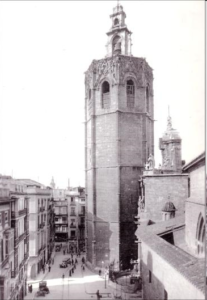
There lay as evidence the guild chapel, and in it the stern lighthouse of the nave, which the malicious unconsciencely claimed to be of many centuries afterwards, and the atbalisms of the guild, and the glorious flag, and the clasped feet of the lion of the whitewashers, in which all their antecesors, had been sheathed, Forgotten now behind the altar, under the looms and dust, but that did not stop being as respectable and true as the chairs of the Miguelete.
Leaving Carrer dels Cavallers, we arrive at one of the busiest places in the city: Plaça de la Verge, where we can admire the Basilica of Our Lady of the Forsaken, and the Cathedral. Precisely, attached to this last religious monument, is the famous tower to which Blasco Ibáñez alluded in the story «The last lion».
The Micalet, called by this name because that is the name of the bell that marks the hours and was baptized on the day of San Miguel Arcángel, is a bell tower, octagonal Gothic, which was built between 1381 and 1429. With 51 meters high to the terrace, you ascend it by a spiral staircase of 207 steps.
There was a time when this building was part of a system of towers distributed along the Mediterranean coast and from which the imminent attack of Barbary pirates was warned. At night, with a bonfire (the smoke) it was indicated that there was no news, but with two bonfires a near danger was warned, while the enemy landing was proclaimed by throwing the bonfire from the top of the tower.
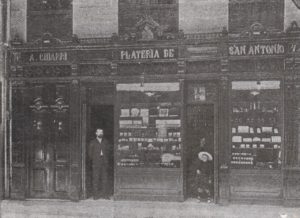
And as a final dignment to that exhibition, in a preferential place, they flaunted the jewels chirping on the maroon shoulder rest of the stupas: the pearl grapes for the ears, the peek rows with their complicated hangings, the great gold horks for the sienna shells, the three sharps with pearl-tightened heads that had to traverse the airy round, and that aderezo, famous in Beni-muslim, that the siñá Tomasa had bought in fourteen elevens in the street of Las Platerías.
We will then walk from the Plaza de la Reina to the church of Santa Catalina, to enter fully into an eminently commercial and tourist urban space. We are guided for this by the story “La cencerrada”, where the effects triggered by Marianne’s wedding are recounted and, before reaching that point, the narrator describes the colorful trousseau and the jewels of the bride’s dowry. For her acquisition, the «siñá Tomasa» went to «carrer de les Argenteries».
In fact, the author had to be referring to an area, located between Martín Mengod and Drets streets and Lope de Vega square, where popular jewelry establishments were installed until the nerve center of commercial life moved to other parts of the city. Blasco Ibáñez, born in Jabonería Nova street (today, corner of Editor Manuel Aguilar street and West Avenue), was well aware of the trajín of goods of various nature that were sold both in the area of Argentería or Les Argenteries, as well as in the immediate Plaza Redona or the New market itself.
La Albufera, a huge lagoon almost confused with the sea, reached the walls; La Huerta was a marsh of juncos and canes that safeguarded in wildness the arrival of the Arabs who crossed it from large and small acequias, forming the wonderful network that transmits the blood of fertility; and where today is the Market extended the river, wide, slow, melting and losing its current in the dead and ashen waters.
The last stage of this journey ends at the Plaza del Mercado, a place that serves as a perfect testimony to highlight the profound transformations experienced by the area, and the city in general. In “The Patriarch’s Dragon” the narrator refers to the Turia’s proximity to this square. But, likewise, we can list the different uses that this vital nucleus of the Valencian urbe has had throughout the centuries. Knightly tournaments, bullfights (until 1743) were held there, but also proclaims, rallies, and even public executions, and a horca was installed in the middle of the square.
The current Central Market, inaugurated in 1928, came to replace the New Market or Los Pórticos, whose inauguration dates from 1839, responding to the need to progressively abandon the outdoor sale of the most different edible products.
In this privileged environment there are also other splendid buildings such as the church of Los Santos Juanes, where Blasco Ibáñez was baptized, and La Lonja.

Blasco Ibáñez birthplace, at number 8 Jabonería Nova street.
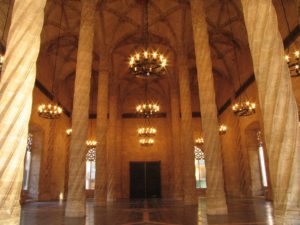
Her lion was as respectable a glory as the Silk Lonja.
Remember that, in “The Last Lion”, the narrator magnifies La Llotja. Indeed, the building is a very respectable “glory” that presides over the Market Square. Precisely, its majesty and artifice, which make it an outstanding example of civil Gothic architecture, also illustrate the commercial and economic strength of Valencia in the fifteenth century. It was this reason that led the General Council of the City to take, in 1469, the decision to build a building that would replace the old Llotja de l’Oli, located in the Plaza del Doctor Collado. It was necessary to have adequate facilities to accommodate commercial transactions, especially silk mills, as well as to house the Consolat del Mar and the Table of Exchanges and Deposits. That is why the building was also known as the Silk or Merchants’ Exchange.
Its construction began in February 1483, being Pere Compte (who had already been in charge of finishing off the extension of the Cathedral) one of the main master stonemasons to carry out a task that, essentially, was finished in about fifteen years. Short time if you consider the beauty of the monumental complex that counts, together with the courtyard of the orange trees, with three magnificent parts. On the one hand, the Pavilion of the Consulate of the Sea and the Tower; then, the Salón Columnario or Procurement Room, where the Table of Changes was installed and is distinguished as an admirable space in which eight helical columns, 16 meters, open like palm trees to form fifteen crossing vaults.
Among the architectural and artistic elements that catch our attention, we must refer to the twenty-eight gargoyles located at the top of the building or the forty Renaissance medallions that, like a frieze, appear on the upper floor of the façade of the Consulate Pavilion.
Declared by UNESCO in 1996 as a World Heritage Site, La Llotja is currently a municipal museum and stands out as one of the emblematic places of the city.